Day 6
May 9, 2003
(Friday)
Naples
8:00 am
We dock at Naples (which the Italians quaintly refer to as "Napoli"),
home of 600,000 people. By the end of the day, we will have driven through
part of it, but not actually seen anything or even talked to any authentic
Neapolitans other than our tour guide, Connie.

Panorama of Naples harbor
8:52 am
Our first stop is the isle of Capri, famous for calf-length pants and
tourists. Augustus Caesar was one of the first tourists, and he had 12
different villas built for him on the island (we guess he always wanted to be
close to a bathroom).
We leap onto a jet foil for the 40-minute trip to Capri island. The air is
hazy and very still, so most of the trip consists of looking at a landscape
that could just as easily be LA, except for the presence of Vesuvius on the
horizon.
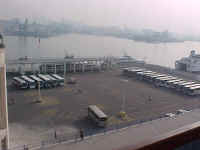
The tour buses await at the dock, but we fool them and take the boat on the
right
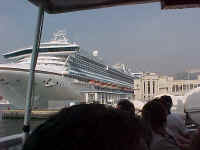
Our boat looms as we leave the dock
Robert begins to wonder about this whole city name thing. Why do we
(Americans) call it "Naples" but the Italians call it "Napoli"? It's not like
we can't pronounce Napoli.
Then Robert begins to wonder if it works the other way, too. Do the Italians
refer to Redmond as "Redomoni"? Is Seattle "Seattillicily"?
Laura wisely reads during this part.
10:00 am
We arrive at Capri. There are two harbors, one on each side. Capri is
essentially a mountain, with houses built along the slopes, except where the
cliffs go straight up and down. Every possible inch of the island is covered
with a house, or a garden (sometimes both, with gardens growing on the roofs
of houses).
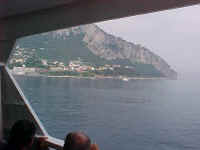
Approaching the Isle of Capri
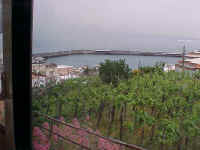
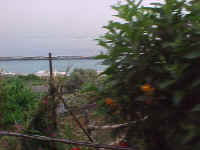
As you ride the tram up to the top of Capri, you can look down on the harbor
We catch a cable car up the hill to the top, which is the main area of the
island. Capri features an abundance of tourists, and at this time of the year,
the tourists are in full bloom. We've been in Grand Central Station in New
York during rush hour, and that looks sparsely populated by comparison.
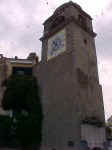
Some ancient, and probably historic clock tower (but not Roman, because they
didn't have clocks back then, but had to use digital watches)
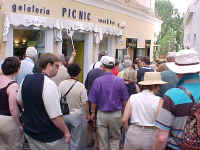
What Capri looks like from our point of view
Our mob pushes its way across the island to the gardens (which are quite
lovely) and we look down the cliffs at the home of Gracie Fields that someone
wanted pointed out. If you're going, "Who the heck is Gracie Fields?" don't
feel bad, so did we. Turns out she was a British singer during WWII who was
very popular with the Italians for entertaining the troops. She married a
Caprinian (Caprisian?) after the war.)
Capri's other money-making activity is growing lemons and making things from
it. You can get lemon perfume, lemon skin cream, lemon soap, lemon candy, and
lemon enemas. Parts of our anatomy pucker just thinking about it.
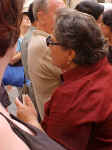
Our tour guide lady Connie

A garden on Capri
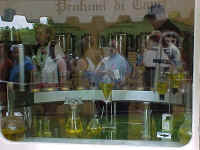
A perfume shop (or a lemon essence factory, one or the other...)
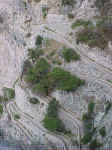
This path leads down to houses that people actually live in--we're guessing
they don't get a lot of door-to-door salespeople
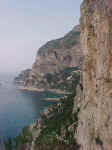
At the bottom of the path, there's just room for some houses
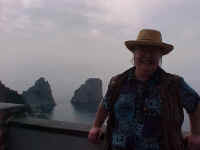
Robert stands in front of some famous landmark or another on Capri
11:30
We have an argument, and Robert grabs the boat tickets and storms off,
saying "Fine! I'll just leave you on Capri!"
Sadly (from Laura's point of view), Robert hears her say "Hot damn!" and comes
back.
We make up, and agree that if that's the only argument all trip, we got off
easy.
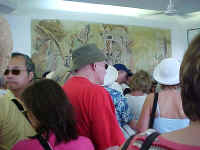
Waiting for the boat
Noon Our mob gets onto another boat, this one labeled "Paul and the Shark."
Apparently, the owner feels this will give tourists a nice warm, fuzzy feeling
about taking his boat to Sorrento back on the mainland. Capri and Sorrento
used to be connected to each other, but this area is geologically active
(hence the volcano) and the two have separated.
Laura spots a fruit vendor on the dock, and buys a paper cone full of
strawberries. They are probably disease-ridden and we'll spend hours in agony
later on, but damn, it'll be worth it! They are very fresh and very tasty and
we spend the boat trip with strawberry juice running down our chins.
12:30 pm
We arrive at Sorrento, which is a town just east of Naples. It's pretty
much a resort town, with a typical Mediterranean flavor to it. It has a
harbor, but the town is built on the top of a cliff overlooking the harbor.
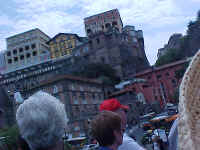
Sorrento, seen from the sea
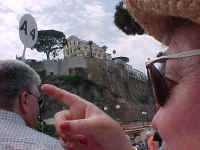
Look! It's Sorrento!
Once we arrive at the top, we go to see an intarsia (inlaid wood)
demonstration. According to Connie, inlaid wood is a big industry in Sorrento.
The demonstration is given by a woman with a Brooklyn accent, who spends most
of the time showing off a gaming table that you can purchase for a mere 4000
Euros (shipping included!).
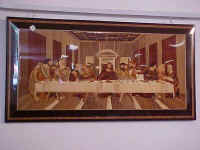
Nope, it's not a painting--it's inlay!
1:00 pm
Lunch! Time for another fabulous local lunch, this one featuring
southern Italian food. The only thing that makes us nervous is that over in a
corner there's a TV set tuned to a cooking show. You can tell it's an Italian
cooking show because the chef is flanked by two babes who's sole purpose is to
exclaim over everything the chef does (Robert wants a kitchen like that!).
Lunch is spinach cannelloni with ricotta cheese. The main course is chicken,
with cheese and potatoes and gravy. Dessert is a tart made with wild
strawberries (wild, or "feral" strawberries are teeny little buggers, but very
sweet).
Our random lunch companions are from Gedden Island, which is right across from
Edmonds (30 miles north of Seattle). Yesterday, we had lunch with a couple
from Lynnwood (two miles north of Seattle). The day before that it was a
Vancouver, BC couple. We begin to wonder what's happening on the West Coast
that's causing everybody to flee to the Mediterranean.
2:00 pm
We have about an hour to kill in Sorrento before the next mob move. We
spot a horse-drawn carriage, so we hire it. The driver takes us up one side of
the town so we can look down across Sorrento (your typical picturesque Italian
seaside town).
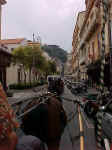
Our horse-drawn carriage makes its way along the streets of Sorrento
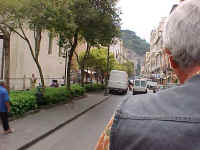
Our driver and Sorrento streets

Panorama of Sorrento harbor

Another panorama (you can just see Vesuvius in the distance to the left of
center)
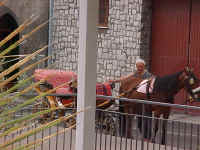
Our driver tending to his horse (and grabbing a smoke break)
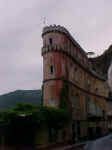
A strange triangular building that caught our attention
Then he heads back into the town and we go down roads that we would call
"narrow alleys" but which at one point were "main drags." Back in the day
(2,000 years ago) people walked a lot, so they built everything close together
and didn't need a heck of a lot of space for roads.
Nowadays, the Italians drive cars and scooters down these alleyways at high
speed (some of the cars passing our carriage with millimeters to spare). Our
driver stops at a Franciscan monastery (which also teaches art classes) and we
can see the attraction of monkhood. The monastery is on the edge of a cliff
with a spectacular view of the harbor and is surrounded by lush vegetation. We
walk through the cloister, which is very relaxing. If the Franciscans had put
a recruiting booth by the door, we would have signed up.
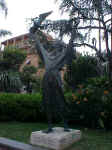
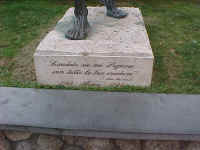
St. Francis whooping it up
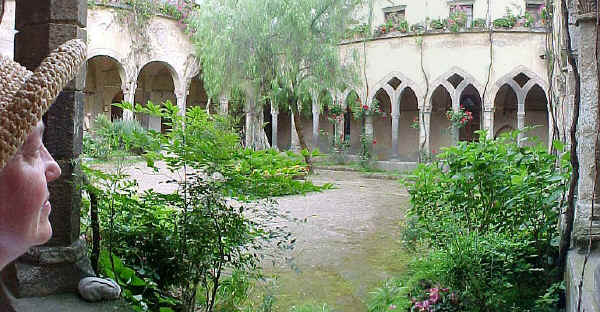
The cloisters of the monastery
When we return to the carriage, the driver points out an inlay shop owned by
his friend Daniel and says we should visit him. We do, and Daniel gives us a
tour of the shop and gives us a MUCH better explanation of how intarsia is
done. His family has been doing this work for three generations in this shop.
Here's the deal: Artists cut the parts of pictures or geometric designs from
thin layers or wood, then fit them back together to reproduce the original
picture. They shellac them to hold them together and then stick the whole
frame into a piece of wood (the "inlay" part). So, for example, if you wanted
to make a checkerboard, you would use a bunch of square pieces of wood.
For these guys, a checkerboard is something that small children make. The real
inlays look like paintings. Daniel quickly determines we are not in the market
for a 4000-euro game table and shows Laura a music box with a view of Sorrento
which plays "Return to Sorrento" for a mere 60 Euros, so she buys it.
In typical European fashion, the guy gift wraps the package (EVERYthing you
buy gets beautifully wrapped). We hope the customs people understand this and
don't panic at a gift-wrapped package full of clockworks....
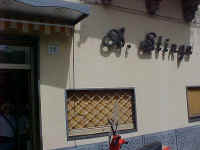
The shop where we got Laura's music box
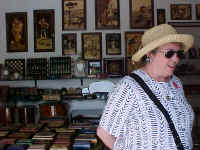
Laura gets excited by all the fancy inlay work
3:00 pm
We're back on the bus and headed for the main attraction: Pompeii!
We are incredibly lucky weather-wise. When we started out this morning at 9:00
it was already 84 degrees, and we weren't looking forward to tromping through
the shadeless ruins for hours. But it has gotten cloudy and much cooler--a
pleasant 72 degrees or so. Connie says this is typical weather for most of the
summer, but usually in May it's clearer. Connie points out much local
agriculture (they've had a few thousand years to figure out what grows well
here).
We can see Mount Vesuvius as we head towards it, and Connie points out that it
is the same type of volcano as Mt. St. Helens (a cone volcano, given to
explosive eruptions, rather than a shield volcano such as Mauna Kea, but don't
get Robert started on this; he can go on for hours about a'a and pahoihoi).
Vesuvius- last erupted in 1944 (steam and ash mostly).
The local history is mostly one of invasions. Everybody has stormed through
Sorrento at one time or another, including the Saxons, Germans, Spanish,
Arabs, you name it, they've conquered Sorrento. As a result, there is no
Sorrento "type" of person. They're blonde, red-headed, brunette, light, dark,
tall, short. It's like a miniature UN.
3:32 pm
We're here at Pompeii. This place is pretty big, an oval about a mile
wide at the longest point and just about every inch is taken up with a house,
or a store, or a street. All carefully excavated during the last 300 years.
(We went on a dinosaur dig years ago, so we can appreciate the huge amount of
work involved in carefully excavating an area this large. Toothbrushes and
dental picks are typical tools....)
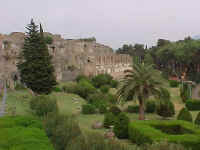
The front of Pompeii
The city was originally built by the Greeks, and then when the Romans showed
up, they liked it so much, they moved in. One way to tell the difference
between the two building styles is that the Greeks tended to use big stones,
while the Romans used smaller stones.
Also, the Romans (bless their standardized little hearts) tended to build
everything from uniform fired bricks, while the naturalist Greeks used natural
stone.
The city is a mixture of intermingled shops and houses. The shops are about 10
feet square, and each has a small groove along the front for a gate so it
could be locked up at night.
One of the biggest buildings is the Law Court which stretches for a good
block. Apparently, even back then lawyering was a good business.
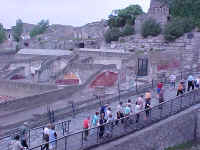
The entrance to Pompeii, with the ruins visible in the background
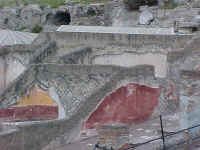
Even some of the colors are preserved
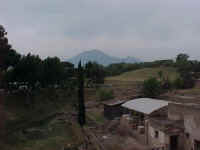
This is the evil, bad guy volcano (Vesuvius) that made all this possible
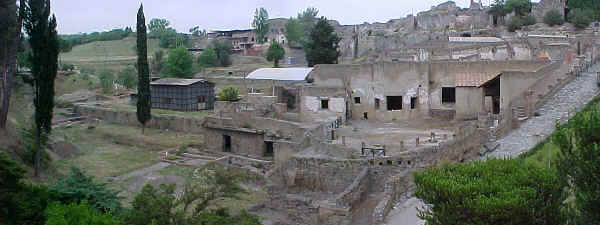
Ruins outside the entrance
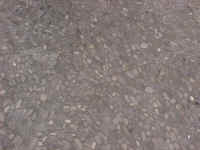
The stones in the walkways are arranged into patterns
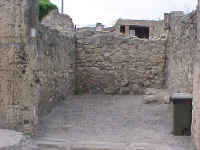
The little slot at the front marks this as a business (a metal gate fit into
the slot, which let the small business owner lock up his shop)

Panorama of Justice Hall
But not as good as the religion biz. There was lots of temples (lots of gods),
and the big one was for a triumvirate of Gods: Jupiter, Juno, and Minerva
(Zeus, Hera, and Aphrodite for those who learned the Greek names). Connie
pointed out (with a slight sneer) that the people were superstitious and were
always praying to Gods and such .
Not like us modern folks, who have absolutely no icons we pray to, or rites to
bless things, or priestly hierarchies.
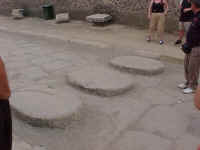
Stepping stones--a vital part of crossing the street, since the street
could be full of water, dirt, and sewage
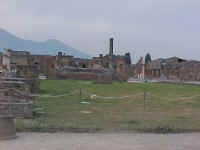
The main temple has seen better days
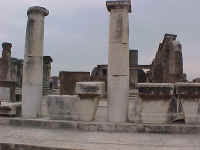
Man, everything is in ruins around here!
Connie really hits her stride when she starts talking about the art of
Pompeii. As those of you who managed to stay awake in art class may remember,
one of the great accomplishments of the Renaissance was the development of
perspective, 3D effects, and realistic human sculpture. Michelangelo and Da
Vinci in particular are widely acclaimed for "discovering" these modern
techniques.
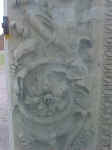
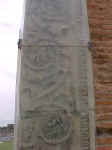
Detail from an arch entryway--notice the 3-D sculptures
Well, guess what, campers--Pompeii is loaded with examples of these
techniques, and these guys beat Leo and Mike by about 1400 years. Some of the
wall frescos survived and Connie points out the use of chiaroscuro (light and
dark to indicate 3D) and of perspective (with vanishing points and
everything).
The people of Pompeii were not ignorant barbarians, but clever people.
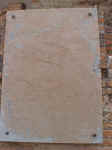
A Roman sign (probably saying "No loitering or skateboarding near the
temple")
There're a couple of the famous volcano people in glass cases, and we got the
story on these. There was an earthquake a couple of days before (back in 79
AD), and the people of Pompeii figured that was all that was happening. So
they didn't flee, and as a result, when Vesuvius exploded, they were caught by
surprise.
There we so much ash and hot gases that people were entombed where they lay
(or stood or cowered). A few hundred centuries later (in the 1700s), the flesh
had all decomposed. When the diggers opened one of these, they peered inside.
This was a bad move, as all the decomposition gases had remained trapped and
when they peered inside, they got a lungful of poison gas and keeled over.
After a number of diggers had bought the farm, an archeologist in 1860 came up
with the bright idea of making a hole in the "dead people space" and then
pouring in plaster to make a mold. This forced the gases out and also created
a very realistic cast of the people--down to the belt buckles.
We try not to think about what these poor people went through (clearly they
all died in great pain).
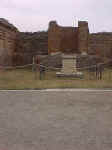
Temple of Vespasian (dedicated to the worship of the Roman Imperium)
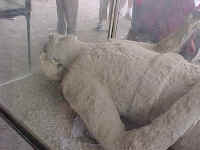
A "body cast" of one of the people caught in the Vesuvius eruption
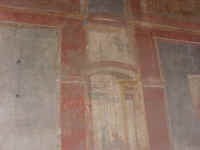
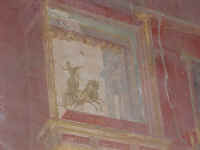
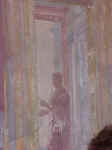
Ha! Those Renaissance bums think they invented perspective! Take a gander
at these 70 AD pictures and eat your wallet Michelangelo!
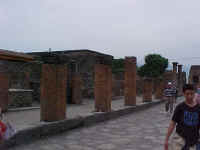
Some Roman pillars, made from standardized bricks
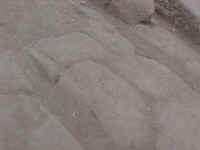
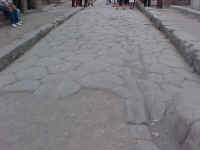
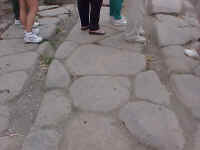
Ruts left by wagons are clearly visible
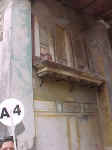
This is a doorway, with a small fake window and balcony as decoration
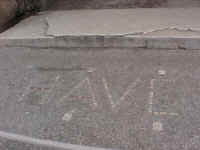
Roman Welcome Mat (really--"Have" is "Welcome")
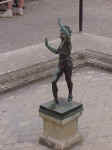
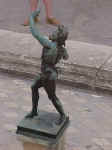
The "Dancing Faun of Pompeii"--this guy stood in a pool outside a rich
person's house, just dancing his little bronze butt off
4:00 pm
The Pompites (Pompesians?) liked to decorate their floors, too. Or
rather, they liked to have waterproof floors, and as long as they were putting
something down, it might as well be decorative. And some of these mosaics are
intricate and stunning. One of them is the classic "reversing cubes" optical
illusion (where the cubes seem to be popping out of the surface in one
direction, but then change direction if you shift your perception).
Apparently, it's a heck of a lot more classic than we thought it was...
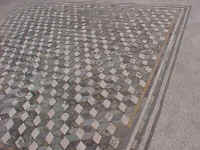
The Romans liked to play Qbert
The mosaics are made from marble, stone, sea shells, and even colored glass.
One of the ones they removed and placed in museum had over 2,000,000 pixels in
it. (Guess we didn't even invent the megapixel picture...)
The Romans also had a fairly intricate water system. They placed water towers
at the highest point in the city and then piped the water down to supply the
public fountains. They even covered the pipes with tiles, so that the water
would remain cool.
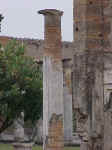
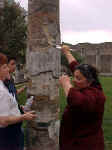
Roman pillars are made from bricks, as Connie points out
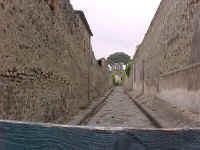
Looking down some road in Pompeii
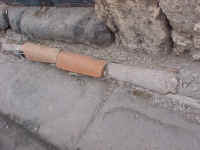
Cold water lead pipes (the tile protects the pipes from the sun and keeps
the water cold)
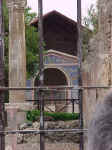
A nice mosaic
Unfortunately, there was no Roman version of the EPA, and all the pipes were
made out of lead. Which means that trace amounts of lead contaminated the
water supply. Lead poisoning tends to make you stupid, stunted, and dead.
There were 30 bakeries in Pompeii and we saw the remains of one of them. Back
then, being a baker was a lot harder than just getting up early. The bakers
also had to grind the grain into flour, and this was done with large grinding
machines that were all human powered. The baking ovens look a lot like they do
today.
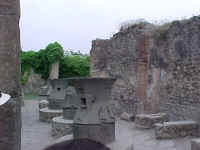
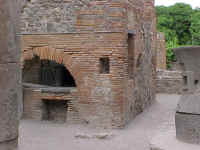
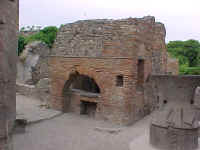
Bakery, where Pompeii bakers ground wheat and made bread (or maybe
pizza--sure looks like a pizza oven to us!)
Around the corner from the bakery was an early McDonaldus, or Fast Food
restaurant. Using amphora pots filled with hot oil, the shop kept food hot and
available quickly for the Pompeii resident in a hurry to get to the wool
market.
We also visited the brothel (it was an inoperative brothel, honest!). The
famous erotic friezes were washed out and barely visible, and didn't really
live up to their reputation. If you were thinking of coming to Pompeii to
check out the erotic art, you'd be better off blowing five bucks on a Playboy
magazine.
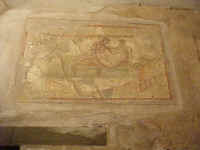
Cheesy erotic fresco
It was fun to see the street sign for the brothel though. The directional
"arrows" were on paving stones in the street and consisted of a twelve-inch
phallus carved into the stone, pointing towards the brothel. Man, those Romans
knew how to make catchy directional arrows!
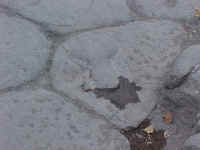
Directional sign for brothel (Roman version of Map Quest)
As we staggered out of Pompeii (it's a big place, and all the paving stones
are uneven, so we spent two hours leaping from stone to stone), our last
question was answered: near the exit, a guy was carefully measuring and
recording information about an exposed pillar, documenting its exact size and
location. They're still finding more bits of Pompeii.
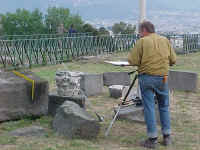
Mr. Grad Student worked on documenting a pillar
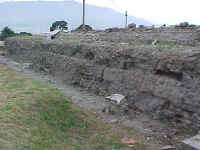
More stuff being uncovered
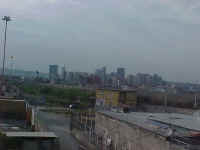
Downtown Naples
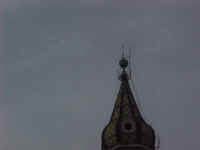
Centuries old tower with months old technology
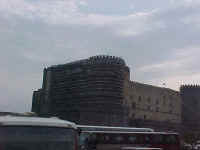
Old Roman fort or maybe medieval; pretty old in any event
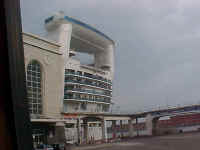
The blunt end of the boat
6:40 pm
Our tour group (always the last tour group to make it back) staggers
on board the ship, which promptly pulls in the gangway and drives away (or
whatever it is that boats do).
We order dinner from room service, as did everybody else it seems, but we're
too tired to complain that it takes an hour to arrive.
Tomorrow we spend the whole day at sea (which isn't anything new for Robert)
and on Sunday, we hit Athens.
Near the boot of Italy
Robert & Laura
|
